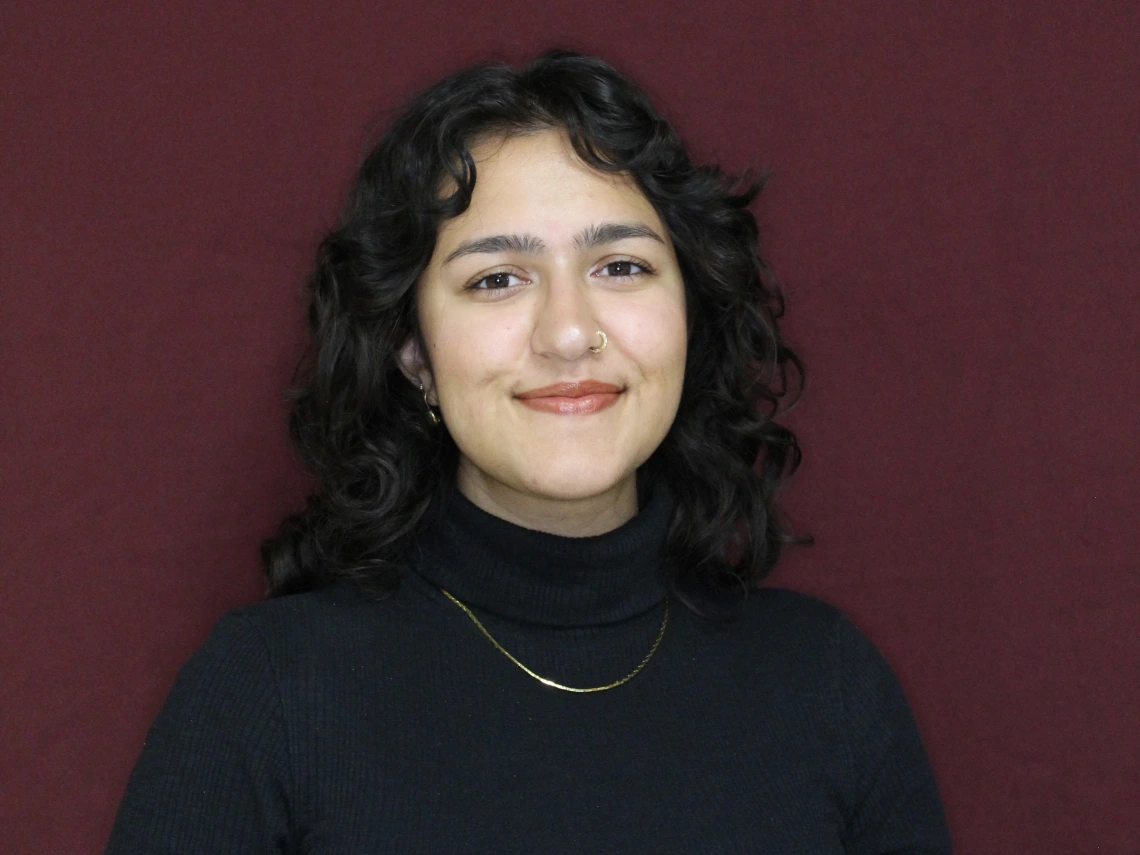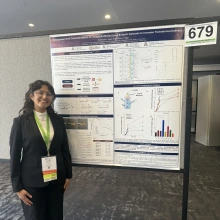Arpita Gulati, a Second-Year Undergrad, Places Second at the ASPET Undergraduate Research Poster Competition

At the 2025 American Society of Pharmacology and Experimental Therapeutics (ASPET) Conference, R. Ken Coit College of Pharmacy undergraduate Arpita Gulati was awarded second place for her poster "Development and Characterization of Linagliptin-Based Deep Eutectic Solvents to Increase Transdermal Delivery" in the Undergraduate Research Poster Competition. Her research shows that pharmaceutically acceptable, lipophilic counterions successfully modified physicochemical and biopharmaceutical properties of LIN, forming amorphous DESs at various ratios depending on the counterion structure. LIN-based DESs demonstrate improved permeability compared to pure LIN, presenting an effective strategy to improve transdermal delivery.

Linagliptin (LIN), a selective DPP-4 inhibitor, is crucial for diabetes patients with chronic kidney disease. However, its low permeability, first-pass metabolism, fluctuating plasma levels, and 30% oral bioavailability limit its effectiveness. Transdermal delivery bypasses first-pass metabolism, enabling steady drug release and improved bioavailability. Deep eutectic solvents (DESs) offer a promising approach to enhance drug solubility and permeability.
To address LIN's bioavailability challenges, they investigated whether highly crystalline LIN could interact electrostatically with biocompatible, permeation-enhancing counterions to form amorphous DES, enhancing LIN permeability for transdermal delivery.
This is relevant as diabetes affects over 828 million adults worldwide, with rising prevalence. Effective management is vital to prevent complications like neuropathy and kidney failure. Dipeptidyl peptidase-4 (DPP-4) inhibitors improve glycemic control by enhancing incretin activity, boosting insulin secretion, and reducing glucagon levels.
Not only did Gulati earn recognition for her work at the annual conference, but she has also received an RII-sponsored Campuswide Undergraduate Student-initiated Original Research Program grant for her research proposal "Can ionic liquids enhance rasagiline's permeability to improve transdermal delivery and Parkinson's treatment outcomes?’”. Additionally, Gulati will continue research at a collaborator's lab at University College Cork through the BRAVO! Program.
Q & A
At the conference, which speaker or session had the biggest impact on you and why?
- On the first day of the conference, there was a “Guppy Tank Translational Science Pitch Competition,” where trainees had worked with mentors to prepare a pitch for their research. Almost every single one of the speakers discussed combining their research with entrepreneurship in a startup, including the keynote speaker of the section, Wassana Yantasee (founder of PDX Pharmaceuticals). I personally really found a passion for pharmaceutical sciences research in learning how so many U of A PIs were engaging in entrepreneurship and getting involved in startups with their research. It is a unique intersection of cool science and being business minded in a way that benefits patients. Given that, it was interesting to hear different researchers at different stages in the process of this.
What was your favorite workshop or hands-on activity, and what made it stand out?
- The welcome reception was such a unique experience for an academic setting. They bussed us out to a gorgeous venue downtown, and all the staff were dressed as gnomes. Yes, that’s right—gnomes! And they all had their own stories and odd props and they just wandered around the venue chit-chatting. It was so random and honestly such a smart way to break the ice, so it made talking to people really easy.
Were there any controversial topics discussed? What were your thoughts on them?
- Two out of four of the keynote speakers discussed using AI in pharmacology/pharmaceutical sciences research. While I’m not the biggest fan of AI, it’s hard to ignore how prevalent it is becoming as a tool, even in research. Laura Kleiman, CEO of Reboot Rx, talked about a unique application of AI as a tool in research on the regulatory barrier side of things. Her company focuses on repurposing existing, generic therapeutics for cancer care. A lot of these drugs have promising data for off-label uses, like for cancer care, but once the patents expire and they become generic drugs, the companies tend to stop pursuing research in these off-label uses. While there may be a significant amount of data suggesting that one of these drugs could be beneficial in cancer care, it then becomes challenging to actually push for the FDA to approve the drugs for cancer care purposes because the companies don’t have incentive to provide a case for the drug anymore. The speaker’s company uses AI to find these drugs that slipped through the cracks, gather the existing evidence for the drugs’ off-label uses, and pass off the information to a team of human scientists, who work to figure out which steps are needed for the final push for approval.
While I tend to dislike AI, I think Dr. Kleiman’s application of an AI tool here is interesting. They use the AI to comb through a data set of 16,000 studies then turn the work over to scientists and lawyers for the final push.
Did you participate in any poster sessions or presentations? How was that experience?
- Yes! I presented a project I started this past summer through the Undergraduate Biology Research Program (UBRP) and won second place in the undergraduate poster session for drug discovery and development. The poster was titled “Development and Characterization of Linagliptin-Based Deep Eutectic Solvents to Increase Transdermal Delivery.” It was so exciting and nerve-wracking to present at a national conference for the first time. I went into the trip nervous about it, but I presented on the last day, so I had a lot of time to get to meet people and listen to others present, so I felt confident by the time it was my turn to present. Through the poster sessions and through my presentation, I got to meet so many interesting people doing interesting science. Someone from an agricultural company came up to my poster and chatted about deep eutectic solvents with me and asked to reach out to my PI, Dr. Date, to explore collaboration. A former wildcat, now in Colorado, came up and asked if I’d want to conduct part of the study at her facilities. I got to chat and connect with some students on gap years, doing research before applying to medical school. It was so fun to talk to such a wide variety of people. That, combined with recent developments with scientific funding in the US, really helped me understand how crucial effective scientific communication is. Even at a conference like ASPET, there weren’t very many people doing research in drug delivery technology, so I had to make sure that my research was digestible and clear for the different people I was talking to. Early on in the poster session, I could see people’s eyes glaze over if I got too technical with the physicochemical characterization, and I realized that I had to tailor the level of detail to what the individual person cared about, depending on their background.
Did you encounter any new research or studies that piqued your interest?
- Someone in the same poster session as me presented on chitosan nanoparticles to co-deliver two different anti-cancer drugs to reduce their toxicity and enhance their bioavailability. It was really interesting research with great data, but we tend to talk about the regulatory barriers on chitosan a lot. Chitosan is produced from chitin, which is a polysaccharide found in crustacean exoskeletons. There has been a lot of cool research using it, but there are very few instances in which the FDA has approved it with concerns about allergens. It would be interesting to see how researchers address the regulatory barrier in translating research with chitosan.

